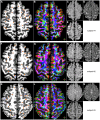Cortical depth dependence of the diffusion anisotropy in the human cortical gray matter in vivo
- PMID: 24608869
- PMCID: PMC3946789
- DOI: 10.1371/journal.pone.0091424
Cortical depth dependence of the diffusion anisotropy in the human cortical gray matter in vivo
Abstract
Diffusion tensor imaging (DTI) is typically used to study white matter fiber pathways, but may also be valuable to assess the microstructure of cortical gray matter. Although cortical diffusion anisotropy has previously been observed in vivo, its cortical depth dependence has mostly been examined in high-resolution ex vivo studies. This study thus aims to investigate the cortical depth dependence of the diffusion anisotropy in the human cortex in vivo on a clinical 3 T scanner. Specifically, a novel multishot constant-density spiral DTI technique with inherent correction of motion-induced phase errors was used to achieve a high spatial resolution (0.625 × 0.625 × 3 mm) and high spatial fidelity with no scan time penalty. The results show: (i) a diffusion anisotropy in the cortical gray matter, with a primarily radial diffusion orientation, as observed in previous ex vivo and in vivo studies, and (ii) a cortical depth dependence of the fractional anisotropy, with consistently higher values in the middle cortical lamina than in the deep and superficial cortical laminae, as observed in previous ex vivo studies. These results, which are consistent across subjects, demonstrate the feasibility of this technique for investigating the cortical depth dependence of the diffusion anisotropy in the human cortex in vivo.
Conflict of interest statement
Figures







References
-
- Thornton JS, Ordidge RJ, Penrice J, Cady EB, Amess PN, et al. (1997) Anisotropic water diffusion in white and gray matter of the neonatal piglet brain before and after transient hypoxia-ischaemia. Magn Reson Imaging 15: 433–440. - PubMed
Publication types
MeSH terms
Grants and funding
LinkOut - more resources
Full Text Sources
Other Literature Sources

